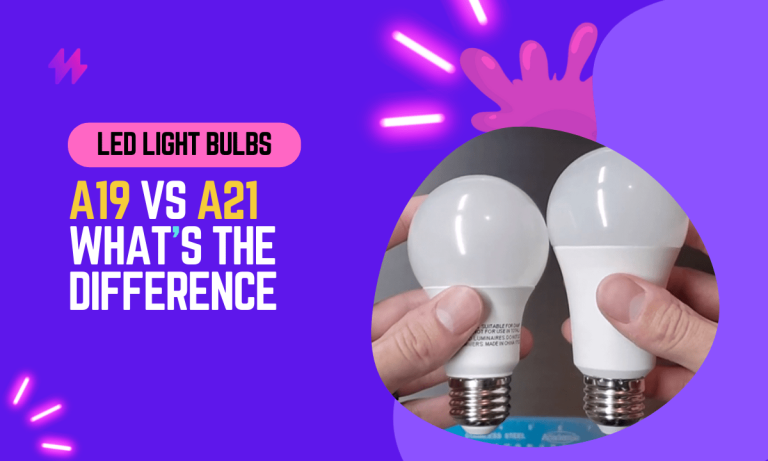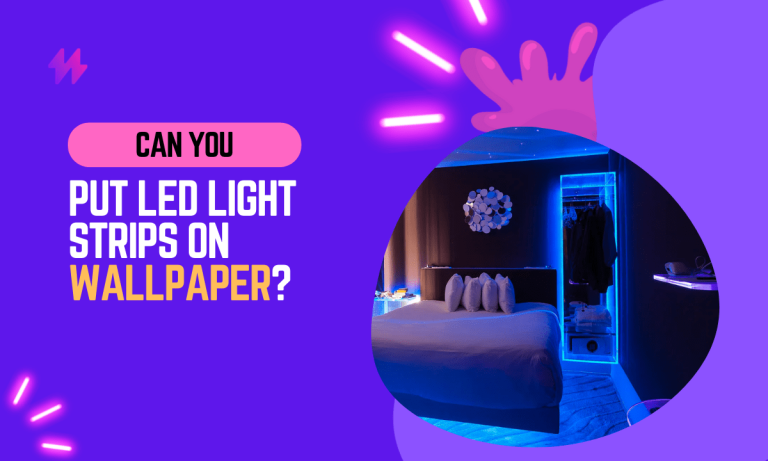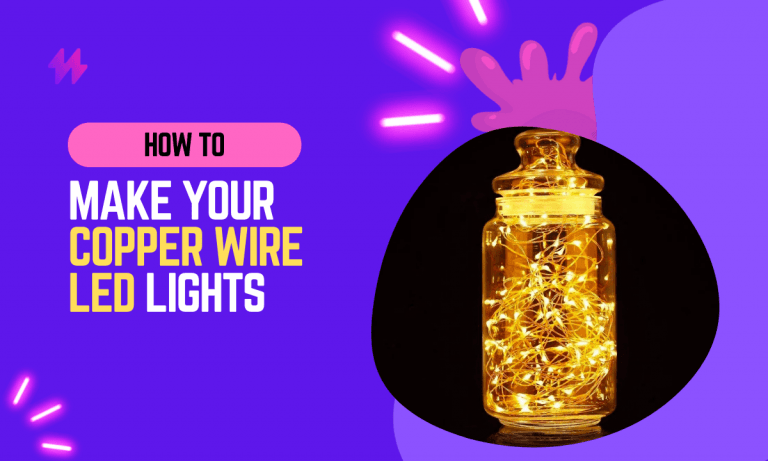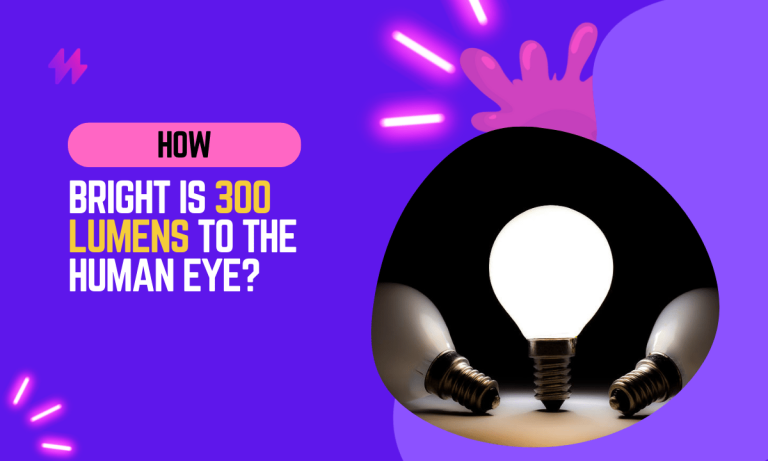How to Install LED Lights Behind TV?
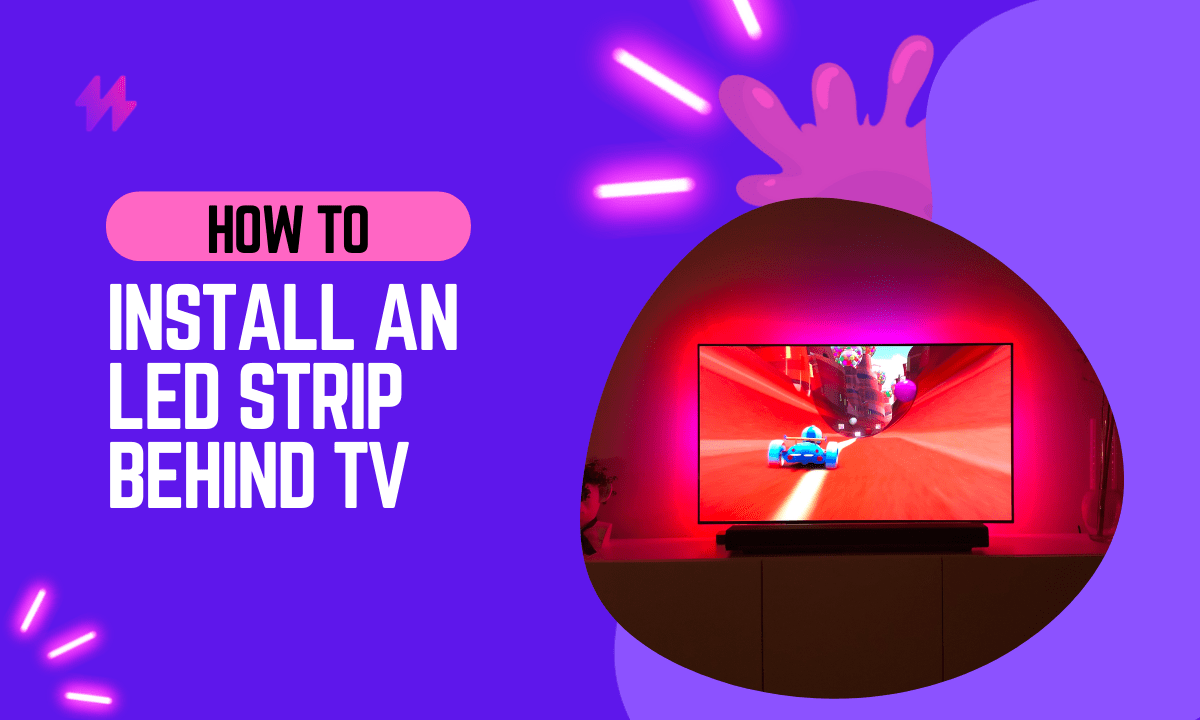
Installing LED lights behind your TV can be a great way to improve the appearance of your home. Not only will it make the room look more polished and professional, but it can also help to improve the viewing experience by adding more light to the space.
In this article, we will discuss the basics of how to install LED lights behind your TV. We will cover everything from choosing the right type of light strip to understanding the basics of wiring and installation. So if you’re looking for a way to take your home theater experience up a notch, read on for our tips on installing LED lights behind TV!
LED lights are becoming increasingly popular as a way to create ambient lighting. LED lights are more energy efficient than traditional incandescent bulbs, and they also last much longer. Additionally, LED lights emit very little heat, making them safe to use around children and pets.
Also read: 5 ways to change LED light color without remote control
LED Lights Behind the TV is a great way to add some extra flair to your home theatre setup or to simply create a more relaxing atmosphere in your living room.
Creating the perfect ambiance in your gaming room is essential for an enjoyable experience, and LED lights can be a game-changer. By incorporating RGBIC lighting effects, you can customize the atmosphere and enhance the visual appeal of your 55-65 inch TVs when hosting movie nights or gaming sessions.
How to Install LED Strip Lights Behind Your TV: Maximizing LED Lights Work
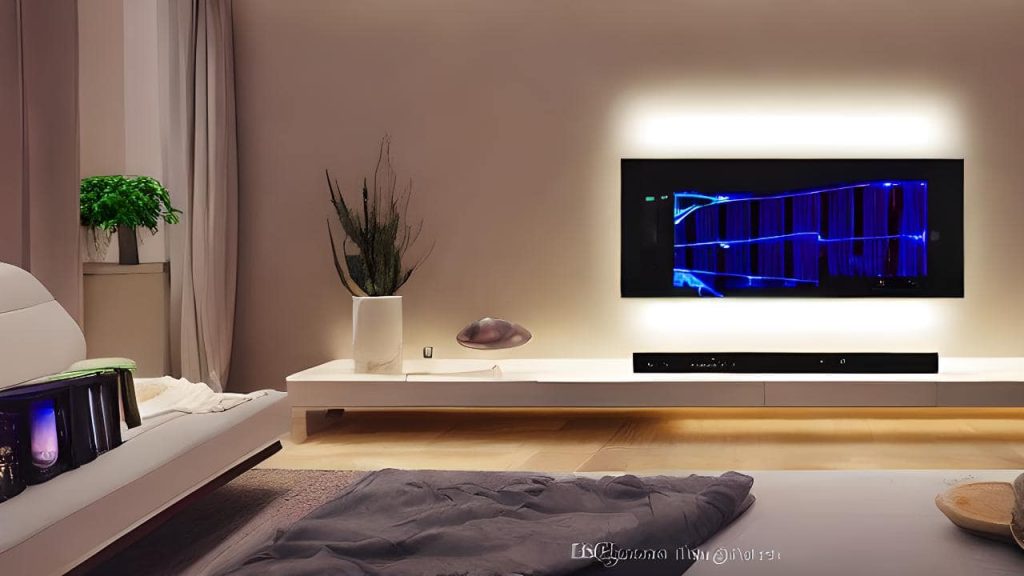
Installing LED lights behind your TV can be a great way to give your home theater the perfect finishing touch. Not only will it create an inviting and professional atmosphere, but it also has plenty of other benefits.
To achieve the ultimate TV-watching experience, it’s crucial to set up quality lights that complement your screen size and enhance visuals. By using smart home devices, such as Philips Hue light strips, you can effortlessly adjust the light settings to match your mood, whether you’re gaming in a dark room or hosting a movie marathon.
How to Install LED Lights Behind TV: Choosing the Right Light Strip for Your LED TV
Selecting the appropriate LED lights is critical and can be difficult. With a wide variety of options available, it’s crucial to take some time to evaluate which product best suits your needs. Depending on factors such as the size of your TV and aesthetic preference, certain LEDs lights may be more suited for you than others.
To create a mesmerizing ambiance with your LED lighting, consider the versatility of light strips and backlights that can sync with your television or computer monitor. Additionally, understanding how to install LED lights behind your TV will ensure that you achieve optimal mood-lighting effects tailored to your preferences, enhancing the overall experience in a dimly lit room.
Essential Steps: Ensure Adequate Power Supply for LED Lights Behind TV
Next, make sure that the power source is adequate for your LED lights. Most LED light strips require a dedicated power source, so it’s important to double-check that your existing setup can provide the necessary wattage before attempting installation.
To maximize the efficiency of your LED lighting setup, it’s essential to ensure that the power supply and electrical outlet can support the optimal operation of your light strips. Additionally, understanding how to install LED lights behind your TV will help you avoid potential issues with inadequate electricity and enhance the overall aesthetic of your awesome-looking gaming room while providing little mood-lighting during those intense gaming sessions.
Decide on Your Preferred Lighting System for LED Lights Behind TV
Finally, you’ll need to decide how you want to control the LED lights. Many LED light strips come with their own remote or app, so make sure you pick one that is compatible with your TV and home theater setup. If your light remote is not working, then checkout our article about resetting LED light remote.
To further enhance your gaming room ambiance, consider utilizing light-emitting diodes (LEDs) as backlights for your large television. This not only provides multicolored lights that complement the visuals on your TV’s bright screen but also transforms your space into an immersive environment perfect for those intense gaming sessions.
How to Effectively Measure Your TV for Backlighting
Once you’ve got all the materials, it’s time to measure your TV for backlighting. Make sure to take precise measurements so that the LED lights fit snugly and securely behind your TV.
Note: Do a dry run when installing your LED strip lights to the back of a TV. This will allow you to make accurate cut lengths and to account for any concaving or protruding surfaces.
To ensure your LED backlights are seamlessly integrated, consider the dimensions of your TV and the available power connection when placing your light strips. Understanding how to install LED lights behind your TV will help enhance your gaming room and allow your TV’s screen to shine in varied colors and effects.
Steps to Install the Light Strip Behind Your TV
When your measurements are done, it’s time to start installing the LED lights. Install each LED light strip along the back of your TV, making sure to follow any instructions provided with the lights.
Once you have your LED lights installed, remember to connect them to an appropriate power supply or adapter that supports their operation. This not only ensures that your lights work effectively but also adds to the overall aesthetic of your awesome-looking gaming room, enhancing your TV’s screen shines with vibrant colors.
Connecting the Power Supply for LED Lights Behind TV
Finally, connect the power source to the LED lights and turn them on. Once everything is connected and powered up, you should be ready to start enjoying your improved home theater experience!
Ensure that you have adequately utilized your power supply/adapter by confirming that your LED lights work efficiently without compromising performance. Moreover, make sure to explore how to install LED lights behind your TV so that your setup is not just functional but also contributes to the overall aesthetic of your awesome-looking gaming rooms.
Simple Guide to Installing LED Lights Behind TV: The Bottom Line
Installing LED lights behind your TV is an easy and affordable way to improve the appearance and experience of your home theater. Not only does it create a more polished and professional atmosphere, but it also adds extra light to the space, helping to maximize viewing enjoyment. With our tips on choosing the right type of light strip and ensuring an adequate power source, you’ll be able to get the most out of your LED lights. So go ahead and give it a try – you won’t regret it!
Transforming your space with LED backlights can significantly elevate your overall TV-watching experience, especially when integrating features like color-sense technology. As you explore how to install LED lights behind your TV, remember that proper alignment with your TV’s size and available USB ports or HDMI outlets will ensure you achieve an aesthetic that complements your decor while enhancing the immersion of your favorite shows.
Final Thoughts on Installing LED Lights Behind TV
In conclusion, installing LED lights behind a TV can significantly enhance your viewing experience by reducing eye strain and improving the perceived image contrast on the screen. This technique, known as bias lighting, not only adds a stylish ambient effect to your home entertainment setup but also serves a functional purpose by providing a consistent light source that is easy on the eyes in low-light viewing conditions. The process involves choosing the right type of LED strip lights, typically USB-powered for easy connection to the TV, and ensuring they are evenly placed around the back perimeter of the TV to create a smooth halo of light on the wall behind it. It is important to select LED strips that match the size and configuration of your TV to achieve the best visual impact and coverage.
Moreover, the installation should be done with care to maintain the integrity of both the LED strips and the TV. Start by cleaning the surface behind the TV to ensure that the adhesive sticks well without peeling off. Planning the layout and connecting the LED strips properly avoids visible wires and ensures that the setup is both aesthetically pleasing and functional. Many LED kits come with customizable settings that allow you to adjust the color and brightness of the lights, enabling you to create the perfect ambiance for all types of media, from intense action movies to mellow music videos. By following these steps, you can create a sophisticated lighting setup that not only enhances your TV’s visual appeal but also contributes to a more enjoyable and comfortable viewing experience.
How To Install LED Lights Behind TV | Tips for Enhancing LED Lights Behind TV
Installing LED lights behind your TV can significantly enhance your viewing experience. To learn how to install LED lights behind TV effectively, consider the size of your TV and the type of light kit you choose. LED strips are a popular option, providing flexibility in positioning while delivering striking backlights that complement the average light in your room. Using devices that allow for colorsense technology ensures your lights match the colors of your screen modes, creating a seamless ambiance. Be mindful of factors like your couch cushions and other furniture that might influence the light’s distribution. Selecting the right lights you’ll use means balancing brightness and color temperature to avoid overpowering your TV’s display while still providing enough illumination in the front. Understanding these elements is essential for achieving the perfect setup.
How to Install LED Lights Behind TV | Selecting the Right Color Temperature for LED Lights
Selecting the right color temperature for LED lights behind your TV can significantly enhance your viewing experience. The lights you’ll use should complement your TV’s size and the overall ambiance of your room. A warm white light can create a cozy atmosphere, while a cooler temperature might make your viewing experience feel more modern. Understanding how to install LED lights behind TV involves choosing the appropriate backlights, such as Aido backlights or light strips, to achieve the desired effect that aligns with your preferences.
Different lights can provide various atmospheres depending on their color temperature. For instance, conventional lights may not offer the same versatility as LED’s, which can switch between warm and cool tones. Utilizing colorsense technology allows you to match your lighting precisely to your TV’s display, enhancing the overall visual quality of your devices. This thoughtful selection ensures that your TV’s setup is not just functional, but also aesthetically pleasing and tailored to your preferences.
Positioning LED Lights for Optimal Ambiance
Optimal placement of LED lights can significantly enhance your viewing experience. To achieve this, consider your TV’s size and the dimensions of the space. Installing light strips behind your TV can create an inviting glow, while the use of Aidot backlights allows for a seamless connection with your devices. This setup helps create a balanced ambiance, preventing eye strain while maintaining focus on the screen. Understanding how to install LED lights behind TV effectively is crucial for achieving the desired effect.
The positioning of the LEDs also plays a pivotal role in the overall aesthetic. Experimenting with different heights and distances can yield various lighting effects. Using Colorsense technology, you can adjust the lights you’ll use to complement the hues projected by your TV. This integration offers a dynamic visual appeal, enhancing your home theater experience. Properly placed backlights can also help define your TV’s space, making an impressive statement that aligns with your decor.
Troubleshooting Common Issues with LED Lights Behind TV
Properly managing common issues with LED lights behind your TV can enhance your viewing experience. Understanding how to install LED lights behind TV is crucial for ensuring optimal functionality. If you encounter flickering, it may be linked to the power supply or the compatibility of your LED’s with your TV’s size and settings. Using backlights or light strips that support Colorsense technology can help sync the lights you’ll use with your TV’s display. Ensuring that your setup provides a consistent power supply will prevent interruptions while you’re using your devices. Keeping these factors in mind allows you to enjoy the ambiance and aesthetic benefits that LED lighting offers.
Resolving Flickering Issues with LED Lights
Flickering issues with LED lights behind your TV can often be attributed to inconsistent power supply or incompatible devices. To troubleshoot, ensure that the light strips you’ll use are compatible with your LED TV. In some cases, using LED backlights with a proper driver can help stabilize the power. It’s essential to select a power source that provides sufficient wattage according to your TV’s size and the total number of LEDs installed. This attention to detail will help eliminate any flicker and enhance your viewing experience.
Another factor to consider is the color temperature set for your LED lights. If your LED’s colors aren’t harmonious with your TV’s display, it could cause flickering effects. Products featuring colorsense technology can automatically calibrate the colors based on your TV’s output, creating a seamless integration. Learning how to install LED lights behind your TV correctly, while ensuring that all connections are secure, will greatly minimize issues. This guarantees that your devices allow for a smooth operation without interruptions.
Ensuring Consistent Power Supply for Your LED Setup
A consistent power supply is vital for the performance of the LED lights you’ll use behind your TV. Different devices allow for various configurations, and understanding how to install LED lights behind TV is crucial for achieving the desired effect. Light strips designed for backlighting should be compatible with your TV’s size and power output. By ensuring that your TV’s power source can adequately support these LED setups, you can prevent flickering or incomplete illumination.
Choosing the correct power adapter for your LED lights can enhance their longevity and reliability. Utilizing devices that incorporate colorsense technology can create a more immersive viewing experience, syncing the LED’s colors with your TV’s display. This thoughtful integration not only accents the backlighting but also harmonizes with your TV’s aesthetics. Whether you’re aiming for a subtle glow or vibrant backlights, a reliable power connection is key to fully enjoying the benefits of LED installation.
Creative Design Ideas for LED Lights Behind TV
Transforming your space with LED lights behind your TV can create stunning visual effects and elevate your viewing experience. Consider how to install LED lights behind your TV by selecting light strips tailored to your TV’s size. The lights you’ll use can enhance the ambiance of your room, providing backlights that reduce eye strain while watching your favorite shows. Utilizing colorsense technology allows you to coordinate the colors with your home decor seamlessly. Choose warm or cool tones based on your aesthetic preferences and how they complement your devices. A thoughtful combination will help create a home theater experience that’s truly immersive and inviting.
Coordinating LED Colors with Your Home Decor
Choosing the right colors for your LED lights is essential to enhance your home decor. Understanding how to install LED lights behind your TV involves selecting light strips that complement your existing color palette. By utilizing colorsense technology, you can coordinate the hues of the backlights with your TV’s size and the overall aesthetic of your living space. These lights you’ll use can create an inviting atmosphere, making your entertainment area more visually appealing.
Consider the devices in your home when determining the best LED colors. For example, if your decor features warm tones, select warm white or soft hues for your LED’s to create a cohesive look. Conversely, cool colors may work well if your space is modern with sleek furniture. Knowing how to install LED lights behind the TV can elevate the ambiance and ensure the lighting fits harmoniously with your TV’s design and surrounding decor.
Using LED Lights to Create a Home Theater Experience
Creating a home theater experience with LED lights begins by understanding how to install LED lights behind your TV. By choosing light strips that are appropriate for your TV’s size, you can achieve a stunning visual effect. Utilizing backlights enhances the depth of your screen and brings the colors of your films to life. It’s crucial to select the right lights you’ll use, such as RGB LED strips, which can provide a variety of colors to match the mood of the content displayed. Incorporating colorsense technology can also add an immersive layer, adjusting the LED hues according to the dominant colors on your TV.
Positioning the LED strips correctly is essential for maximizing their impact. The ideal placement of these backlights will not only illuminate the space but also reduce eye strain during prolonged viewing. Your devices allow for versatile configurations, so consider experimenting with different colors and brightness levels for varying genres. Whether you prefer subtle tones for romantic comedies or vibrant hues for action-packed thrillers, the right setup can transform your viewing area into a captivating home theater. Understanding how to install LED lights behind your TV gives you the power to customize your environment to enhance every cinematic experience.


